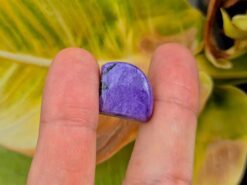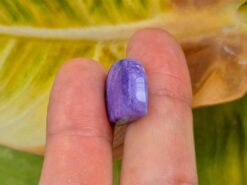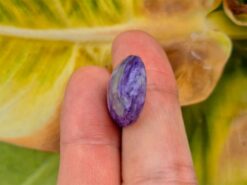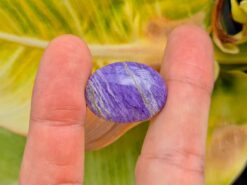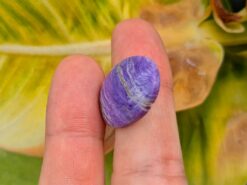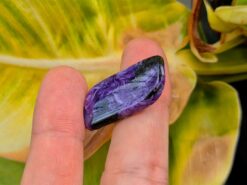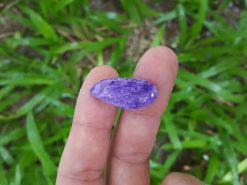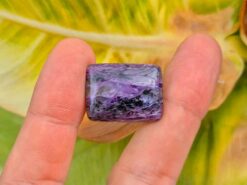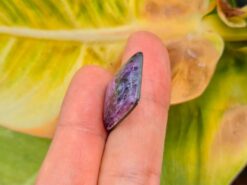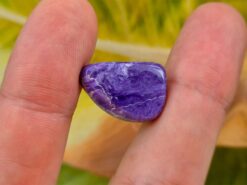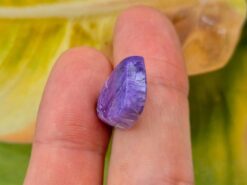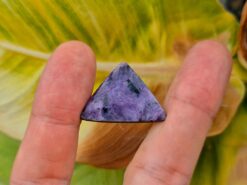Charoite
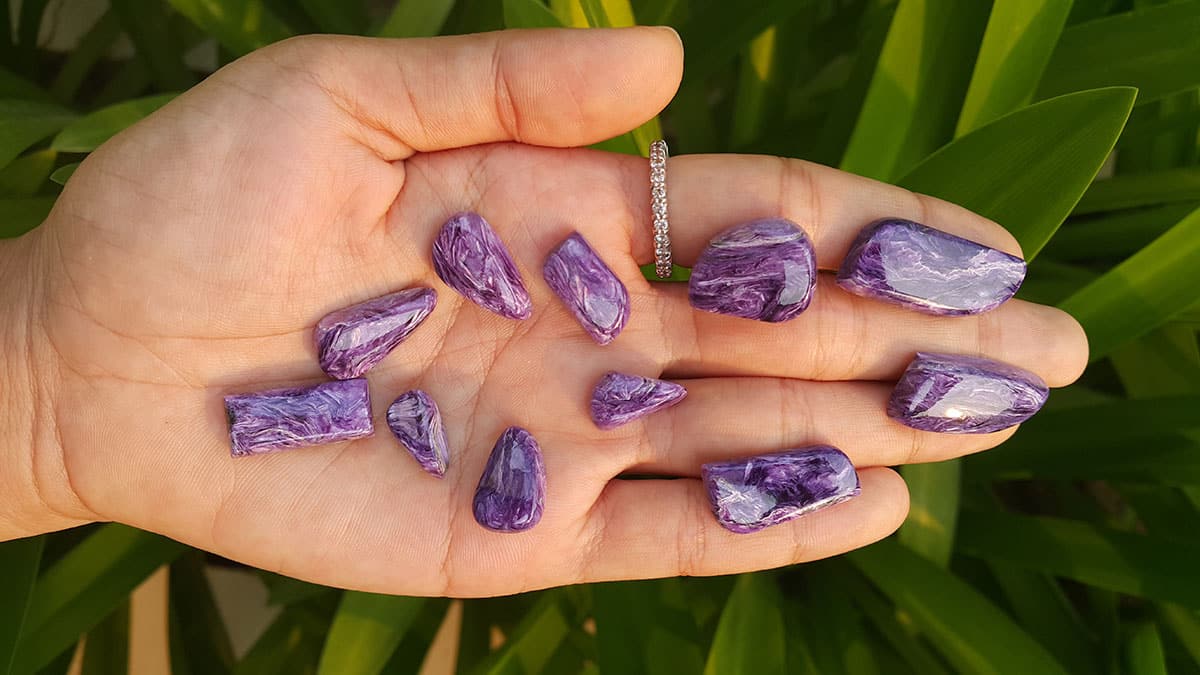
Buy natural charoite in our shop
Charoite crystal stone meaning and healing properties<
Charoite stone is a rare and fascinating mineral known for its mesmerizing patterns in shades of lavender, lilac, and deep purple. It was first described in 1978 and takes its name from the Chara River in the Sakha Republic, Siberia, Russia. The stone is formed under unique geological conditions, where syenite from the Murunskii Massif intruded into limestone deposits, creating a potassium feldspar metasomatite that eventually produced vibrant charoite crystals.
This crystal is strictly massive in nature, with a pearly to silky luster and swirling, fibrous veins that give it an almost otherworldly appearance. Some specimens even exhibit a chatoyant effect, reflecting light in subtle rays across their surface. While charoite might appear synthetic at first glance due to its distinctive coloration and patterns, it is an entirely natural stone prized by gem collectors, jewelry designers, and mineral enthusiasts alike.
Because of its distinct patterns, charoite stone has long intrigued both geologists and those interested in the stone’s reputed energetic properties. It remains relatively rare and can typically be sourced only from Siberia, making it highly sought after for both ornamental and metaphysical purposes.
Charoite properties and origins
Charoite owes its name to the Chara River in Siberia, the region where it was originally identified. Although initial discovery might date back to the 1940s, the stone did not gain recognition until 1978, when it was officially described by the Russian mineralogist Rogova and colleagues. The Chara River lies in a remote area of the Republic of Sakha, known for its extremes in climate and its wealth of mineral resources.
The geological process that forms charoite is rather complex. Potassium feldspar metasomatism occurs when syenite intrudes and alters limestone deposits, producing this unique mineral. Charoite typically appears opaque or translucent and can display vibrant, swirling patterns of purple, white, and black. In some cases, small flecks or threads of aegirine or other minerals may be present, adding interesting variations to the stone’s overall look.
Despite its name being tied to Siberian locality, charoite stone symbolizes transformation and spiritual development for many people. In local folklore, it was sometimes associated with shifting energy and freedom from negative constraints. Some historical anecdotes suggest that peasants in the Urals had traditions referencing shamanic rituals that valued purple stones like charoite for spiritual and celebratory purposes.
Russia remains the most notable source for premium-quality charoite, and it’s no surprise that collectors eagerly seek out the finest rough specimens from this region. The rare character of this stone, coupled with its striking patterns, makes it a prized addition to mineral collections.
Charoite forms in association with tinaksite and canasite, among other minerals. It measures 5.5 to 6 on the Mohs hardness scale, making it durable enough for a variety of jewelry applications. Its density ranges from 2.54 to 2.58 g/cm³. Though it is moderately tough, care should be taken to protect it from sharp impacts or harsh chemicals that may damage its natural sheen.
Charoite meaning and healing properties
The following section is pseudo scientific and based on cultural beliefs.
Charoite stone is widely revered as a stone of transformation. Many believe that charoite cleanses the aura and chakras by transmuting negative energy into beneficial, healing vibrations. It is said to promote the heart’s capacity for unconditional love and compassion, thereby bolstering emotional resilience and spiritual awareness.
In various holistic traditions, charoite is rumored to help balance the body’s energy flow and provide relief from stress. It is thought to activate the crown and heart chakras, aligning their energies to encourage spiritual insight, clarity, and emotional healing. This gem is also associated with improving sleep, alleviating insomnia, and warding off nightmares.
Physically, some believe charoite may support overall well-being by benefiting the eyes, heart, liver, and pancreas, as well as aiding nervous system function. While these claims are not scientifically proven, many individuals incorporate charoite into meditative and wellness practices, finding comfort in its supportive properties.
Charoite under microscope
FAQ
What is charoite used for?
Charoite is often used for decorative purposes, in jewelry, and in holistic practices. It is believed to regulate blood pressure and pulse rate, improve sleep, and calm the nervous system. Many people incorporate charoite into meditation or wear it daily to harness its reputed transformational energies.
Is charoite expensive?
Despite its rarity, charoite is generally considered an affordable gemstone. It is commonly used in jewelry as raw beads or cabochon pieces, and a single carat usually costs only a few dollars. The stone’s value can vary based on color saturation, chatoyancy, and overall quality.
What is the difference between sugilite and charoite?
Both stones exhibit violet to purple hues, but sugilite lacks the distinctive swirling patterns commonly seen in charoite. Sugilite also doesn’t display the slight to moderate chatoyancy frequently found in many charoite stones. This swirling or fibrous appearance is one of the main ways to distinguish charoite from other gems.
How can you tell if charoite is real?
Authentic charoite typically features a mottled appearance with an iridescent sheen and banding. You may also find patches of green or black minerals, such as aegirine, and sometimes orange tinaksite threads. These natural inclusions help verify the stone’s genuineness.
Where is charoite found?
Charoite is found exclusively in the Chara River area in the Murun Massif, located in Northwest Aldan of the Sakha Republic, Russia. Its formation is the result of contact metamorphism, where limestone deposits were altered by intruding syenite, creating this remarkable purple gem.
What color is charoite?
Charoite ranges from opaque to translucent and exhibits lavender to deep purple hues. It has a pearly luster and distinctive fibrous or swirly patterns that stand out among purple gemstones.
Natural charoite for sale in our gem shop
We create custom-made charoite jewelry, including engagement rings, necklaces, stud earrings, bracelets, and pendants. If you are interested in a unique piece featuring this remarkable stone, please
contact us for a quote.

